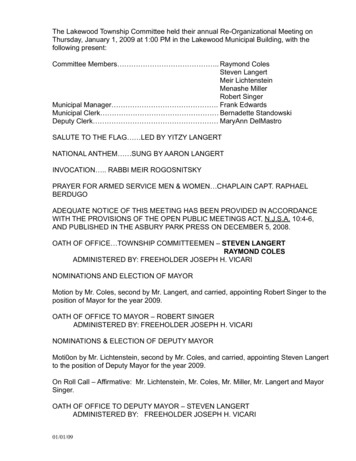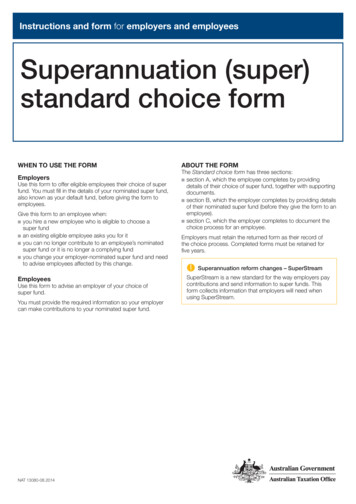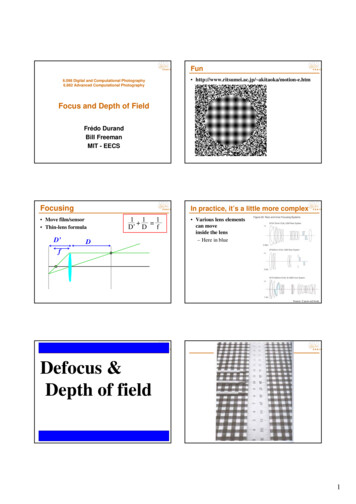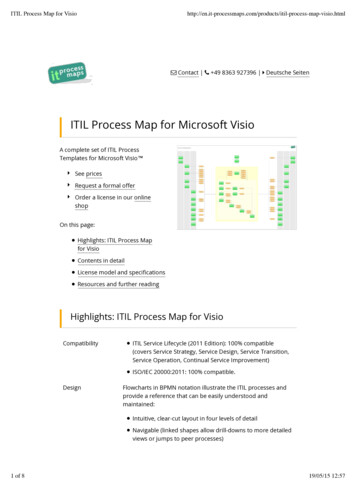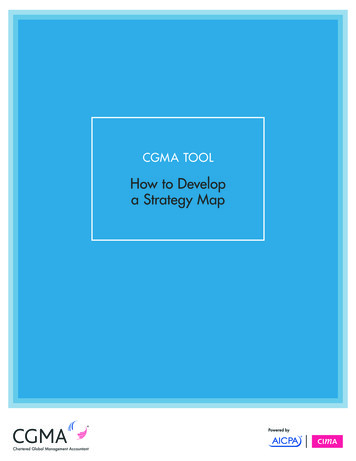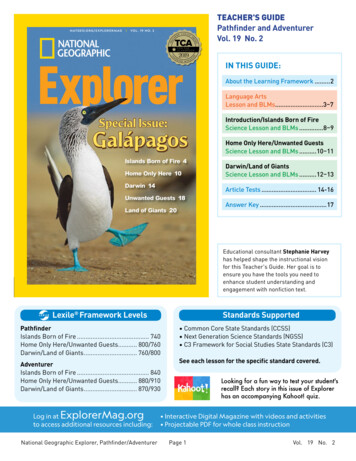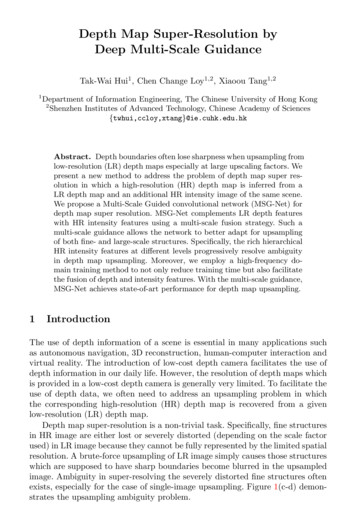
Transcription
Depth Map Super-Resolution byDeep Multi-Scale GuidanceTak-Wai Hui1 , Chen Change Loy1,2 , Xiaoou Tang1,21Department of Information Engineering, The Chinese University of Hong Kong2Shenzhen Institutes of Advanced Technology, Chinese Academy of . Depth boundaries often lose sharpness when upsampling fromlow-resolution (LR) depth maps especially at large upscaling factors. Wepresent a new method to address the problem of depth map super resolution in which a high-resolution (HR) depth map is inferred from aLR depth map and an additional HR intensity image of the same scene.We propose a Multi-Scale Guided convolutional network (MSG-Net) fordepth map super resolution. MSG-Net complements LR depth featureswith HR intensity features using a multi-scale fusion strategy. Such amulti-scale guidance allows the network to better adapt for upsamplingof both fine- and large-scale structures. Specifically, the rich hierarchicalHR intensity features at different levels progressively resolve ambiguityin depth map upsampling. Moreover, we employ a high-frequency domain training method to not only reduce training time but also facilitatethe fusion of depth and intensity features. With the multi-scale guidance,MSG-Net achieves state-of-art performance for depth map upsampling.1IntroductionThe use of depth information of a scene is essential in many applications suchas autonomous navigation, 3D reconstruction, human-computer interaction andvirtual reality. The introduction of low-cost depth camera facilitates the use ofdepth information in our daily life. However, the resolution of depth maps whichis provided in a low-cost depth camera is generally very limited. To facilitate theuse of depth data, we often need to address an upsampling problem in whichthe corresponding high-resolution (HR) depth map is recovered from a givenlow-resolution (LR) depth map.Depth map super-resolution is a non-trivial task. Specifically, fine structuresin HR image are either lost or severely distorted (depending on the scale factorused) in LR image because they cannot be fully represented by the limited spatialresolution. A brute-force upsampling of LR image simply causes those structureswhich are supposed to have sharp boundaries become blurred in the upsampledimage. Ambiguity in super-resolving the severely distorted fine structures oftenexists, especially for the case of single-image upsampling. Figure 1(c-d) demonstrates the upsampling ambiguity problem.
2T.-W. Hui, C. C. Loy, X. Tang(a)(b)(c)(d)(e)Fig. 1: Ambiguity in upsampling depth map. (a) Color image. (b) Ground truth.(c) (Enlarged) LR depth map downsampled by a factor of 8. Results for upsampling: (d) SRCNN [11], (e) Our solution without ambiguity problem.(a)(b)(c)(d)(e)Fig. 2: Over-texture transfer in depth map refinement and upsampling usingintensity guidance. (a) Color image. (b) Ground truth. (c) Refinement of (b)using (a) by Guided Filtering [8] (r 4, 0.012 ). Results of using (a) to guidethe 2 upsampling of (b): (d) Ferstl et al. [4], (e) Our solution.To address the aforementioned problem, a corresponding intensity image1is often used to guide the upsampling process [1–7] or enhance the low-qualitydepth maps [8–10]. This is due to the fact that a correspondence between anintensity edge and a depth edge can be most likely established. Since the intensityimage is at a higher resolution, its intensity discontinuities can be used to locatethe associated depth discontinuities in a higher resolution. Although there couldbe an exception that an intensity edge does not correspond to a depth edge orvice versa, this correspondence assumption has been used widely in the literature.One would encounter issues too in exploiting the intensity guidance. Specifically, suppose we have a perfectly registered pair of depth map D and intensityimage Y possessing the same resolution. It is not straight forward to use Y toguide the refinement of D or the upsampling of LR D. The variation of depthstructures in D may not be consistent with that of the intensity structures in Yas they are different in nature. Using image-guided filtering, features in intensityimages are often over-transferred to the depth image at the boundaries betweentextured and homogeneous regions. Figure 2(c-d) illustrates two examples forthe over-texture transferring problem. Our proposed method that complementsD with only consistent structures from Y can avoid this problem (Fig. 2(e)).1Intensity image represents either a color or grayscale image. We only study grayscaleimage in this paper.
Depth Map Super Resolution by Deep Multi-Scale Guidance3In this paper, we present a novel end-to-end upsampling network, a MultiScale Guided convolutional network (MSG-Net), which learns HR features in theintensity branch and complements the LR depth structures in the depth branchto overcome the aforementioned problems. MSG-Net is appealing in that it allows the network to learn rich hierarchical features at different levels. This in turnmakes the network to better adapt for upsampling of both fine- and large-scalestructures. At each level, the upsampling of LR depth features is closely guidedby the associated HR intensity features possessing the same resolution. Theintegrated multi-scale guidance progressively resolves ambiguity in depth mapupsampling. We further present a high-frequency training approach to reducetraining time and facilitate the fusion of depth and intensity features. Note thatunlike existing super-resolution networks [11, 12] that require pre-upsamplingof input image by a conventional method such as bicubic interpolation outsidethe network. Our approach learns upsampling kernels inside a network to fullyexplore the upsampling ability of a CNN. We show that such a multi-scale upsampling method uses a more effective way to upscale LR images, while capableof exploiting the guidance from HR intensity features seamlessly.Contributions: (1) We propose a new framework to address the problem ofdepth map upsampling by complementing a LR depth map with the corresponding HR intensity image using a convolutional neural network in a multiscale guidance architecture (MSG-Net). To the best of our knowledge, no priorstudies have proposed this idea for CNN before. (2) With the introduction ofmulti-scale upsampling architecture, our compact single-image upsampling network (MS-Net) in which no guidance from HR intensity image is present alreadyoutperforms most of the state-of-the-art methods requiring guidance from HRintensity image. (3) We discuss detailed steps to enable both MSG-Net andMS-Net to perform image-wise upsampling and end-to-end training.2Related workThere is a variety of methods to perform image super resolution in the literature.Here, we categorize them into four groups:Local methods are based on filtering. Yang et al. used the joint bilateral filter[1] to weight the degree of smoothing in each depth patch by considering thecolor similarity between the center pixel and its neighborhood [13]. Liu et al.designed the upsampling weights using geodesic distances [14]. With the use ofimage segmentation, Lu et al. developed a smoothing method to reconstructdepth structures within each segment [6].Global methods formulate depth upsampling as an optimization problem wherea large cost is given to a pixel in depth map if neighboring depth pixels havesimilar color in the associated intensity image but different depth values. Diebelet al. proposed Markov Random Field (MRF) formulation, which consists of adata term from LR depth map and a smoothness term from the corresponding HR intensity image for depth upsampling [15]. Park et al. utilized nonlocalmeans filtering in which intensity features are acted as weights in depth regular-
4T.-W. Hui, C. C. Loy, X. Tangization [2]. Ferstl et al. used an anisotropic diffusion tensor to regularize depthupsampling [4]. Yang et al. developed an adaptive color-guided auto regressionmodel for depth recovery [5]. Aodha et al. especially focused on single-imageupsampling as MRF labeling problem [16].Dictionary methods exploit the relationship between a paired LR and HRdepth patches through sparse coding. Yang et al. sought the coefficients of thisrepresentation to generate HR output [17]. Timofte et al. improved sparse-codingmethod by introducing the anchored neighborhood regression [18]. Ferstl et al.proposed to learn a dictionary of edge priors for an anisotropic guidance [19].Li et al. proposed a joint examples-based upsampling method [20]. Kwon et al.formulated an upscaling problem which consists of scale-dependent dictionariesand TV regularization [7].CNN-based methods are in distinction to dictionary-based approaches in thatCNN do not explicitly learn dictionaries. With the motivation from convolutional dictionaries [21], Osendorfer et al. presented a convolutional sparse coding method for super-resolving images [22]. Wang et al. developed a cascade ofsparse coding based networks (CSCN) [12] that are constructed by using modulesfrom the network for the learned iterative shrinkage and thresholding algorithm(LISTA) [23]. However, their decoder uses sparse code to infer a HR patch separately. All the recovered patches are required to put back to the correspondingpositions in HR image. Dong et al. proposed an end-to-end super-resolutionconvolutional neural network (SRCNN) to achieve image restoration [11].Comparing to the above methods, our CNNs exhibit several advantages. Wedo not explicitly formulate an optimization problem as the global methods [2,4, 5, 15] or design a fixed filter as the local methods [6, 13, 14] because CNN canbe trained to address the upsampling problem. In contrast to the dictionarymethods [7, 19], our networks are self-regularized. No extra regularization onthe upsampled image is necessary outside the network. In distinction to othersingle-image super resolution CNNs [11, 12, 22], our networks do not use a singlef ixed (non-trainable) upsampling operator. More importantly, our MSG-Netis specifically designed for image-guided depth upsampling. Rich hierarchicalfeatures in the HR intensity image are learned to guide the upsampling of theLR depth map progressively in multiple levels towards the desired HR depthmap. The multi-scale fusion architecture in turn enables MSG-Net to achievehigh-quality upsampling performance especially at large upscaling factors.Our work is related to the multi-scale CNNs for semantic segmentation(FCN) [24], inferring images of chairs [25], optical flow generation (FlowNet) [26]and holistically-nested edge detection (HED) [27]. Our network architecture differs from theirs significantly. An upsampling network is used in [25]. A downsampling network is used in HED. A downsampling sub-network followed by anupsampling sub-network is used in FlowNet and FCN. We use an upsampling(depth) branch in parallel with a downsampling (intensity) branch. This networkarchitecture has not been studied yet. In common to [24–26], we use multiplebackwards convolutions for upsampling. But we do not use feed-fowarding andunpooling. All the above networks do not use deep supervision except HED.
Depth Map Super Resolution by Deep Multi-Scale Guidance35Intensity-guided depth map upsamplingSuppose we have a LR depth map Dl which is down-sampled from its HR counterpart Dh . Additionally, a corresponding HR intensity image Yh of the samescene is available. Our goal is to recover Dh using Dl and Yh .We first present some insights about the upsampling architecture. Thesemotivate us on the design of our proposed upsampling CNNs.Spectral decomposition. We have observed that simple upsampling operatorlike bicubic interpolation performs very well in smooth region, but sharpness islost along edges. Unlike SRCNN [11] and CSCN [12], we do not enlarge Dlusing a fixed upsampling operator and then refine the enlarged Dl afterwards.To achieve optimal upsampling, we believe that different spectral components ofDl need to be upsampled using different strategies because a single upsamplingoperator is unlikely to be suitable for upsampling of all kinds of structures.Multi-scale upsampling. Multi-scale representation has played an importantrole in the success of addressing low-level problems like motion-depth fusion [28],optical flow generation [24] and depth map recovery [7]. Different structures inan image have different scales. A multi-scale upsampling CNN that allows theuse of scale-dependent upsampling kernels can greatly improve the quality of therecovered HR image especially at large upscaling factors.3.1FormulationWe design MSG-Net to upsample a LR image Dl not in a single level but profh with multi-scale guidancegressively in multiple levels to a desired HR image Dfrom the corresponding HR intensity image Yh . We upsample Dl in m levels forthe upscaling factor 2m . Figure 3 shows an overview of the network architecture.It consists of five stages, namely feature extraction (each for Y - and D-branches),downsampling, upsampling, fusion and reconstruction. We will discuss the details of each stage in this section.Overview. It is not possible to determine the absolute depth value of a pixelfrom an intensity patch alone as it is an ill-posed problem. Flat intensity patches(regardless of what intensity values they possess) do not contribute much improvement in depth super resolution. Therefore, we complement depth featureswith the associated intensity features in high-frequency domain. In other words,we perform an early spectral decomposition of Dl : Dl l(Dl ) h(Dl ). Byusing the high-frequency (h) components of both Y and D images as the inputs,this gives room for the network to focus on structured features for joint upsampling and filtering. This in turn improves the upsampling performance greatly.We have also experienced a reduction in the convergence time if the network aretrained in high-frequency domain. We obtain the high-frequency components ofDl , Dh , and Yh by applying a low-pass filter Wl to them as follows:h(Dl ) Dl Wl Dl ,h(Dh ) Dh (Wl Dl )h(Yh ) Yh Wl Yh ,(1.1) Dh,(1.2)(1.3)
6T.-W. Hui, C. C. Loy, X. TangFig. 3: The architecture of MSG-Net. For the ease of representation, only anupsampling CNN with upscaling factor 8 is presented. There are three multiscale upsampling levels. Each level consists of an upsampling and a fusion stage.where (Il ) Dh performs a bicubic upsampling on Il to the same resolution as Dh .Suppose the upscaling factor is s 2m , then there are M layers (including mupsampling levels) in the main branch and 2m layers in the Y branch. MSG-Netcan be expressed as follows:YF1Y σ(Wc(1) h(Yh ) bY1 ), (feature extraction)(2.1)YYFjY σ(Wc(j) Fj 1 bYj ), (post-feature extraction)(2.2)YF2j0 Ymaxpool(F2j0 1 ),(downsampling)F1 σ(Wc(1) h(Dl ) b1 ), (feature extraction) Fk σ Wd(k) ? Fk 1 bk , (upsampling) Y, Fk bk 1 , (fusion)Fk 1 σ Wc(k 1) F2(m 1 k/3) Fk 2 k0 σ Wc(k 2 k0 ) Fk 1 k0 bk 2 k0 , k 0 {0, 1} (post-fusion)(2.3)(2.4)(2.5)(2.6)(2.7)fh ) Wc(M ) FM 1 bM , (reconstruction)FM h(D(2.8)fh D(2.9)fh h(Dfh ) (Wl Dl )D, (post-reconstruction)where j {2, 3, 5, ., 2m 1}, j’ {4, 6, ., 2m}, k {2, 5, ., 3m 1} andM 3(m 1). The operators and ? represent convolution and backwardsconvolution respectively. Vectors (or blobs) having superscript Y in (2) belongsto HR intensity (Y ) branch of MSG-Net. Wc(i)/d(i) is a kernel (subscripts c andd stand for convolution and deconvolution respectively) of size ni 1 fi fi ni(ni 1 and ni are the numbers of feature maps in the (i 1)th and ith layers,respectively) and bi is a ni -dimensional bias vector (it is a scalar in the toplayer). Each layer is followed by an activation function for non-linear mappingexcept the top layer. We use parametric rectified linear unit (PReLU) [29] asthe activation function (σ) due to its generalization and improvement in model
Depth Map Super Resolution by Deep Multi-Scale Guidance7fitting, where σ(y) max(0, y) a min(0, y) and a is a learnable slope coefficientfor negative y.Denote F as our overall network architecture for MSG-Net and Θ {W, b, a}as the network parameters controlling the forward process, we train our networkby minimizing the mean squared error (MSE) for N training samples as follows:L(Θ) 1 XN F (h(Yh(i) ), h(Dl(i) ); Θ) h(Dh(i) ) 2 .i 1N(3)The loss is minimized using stochastic gradient descent.Feature extraction. MSG-Net first decomposes a LR high-frequency depthmap h(Dl ) and the associated HR high-frequency image h(Yh ) into differentspectral components (sub-bands) at the bottom layer and the first two layersof the D- and Y -branches respectively. This facilitates the network to learn forscale-dependent and spectral-dependent upsampling operators afterwards.Multi-scale upsampling. We perform upsampling in m levels. Backwardsconvolution (or so-called deconvolution) (deconv) in the ith layer is used to upsample the sub-bands Fi 1 {f(i 1,j) , j 1, ., ni 1 } in the (i 1)th layer. Eachdeconv layer has a set of trainable kernels Wd(i) {wd(i,j) , j 1, ., ni } suchthat wd(i,j) {wd(i,j,k) , k 1, ., ni 1 } and wd(i,j,k) is a fi fi filter. Deconvrecovers the j th HR sub-band in the ith layer by utilizing the dependency acrossall LR sub-bands in the (i 1)th layer as follows:Xni 1f(i,j) wd(i,j,k) ? f(i 1,k) b(i,j) .(4)k 1More specifically, each element in a HR sub-band is constructed by element-wisesummation of a corresponding set of enlarged blocks of pixels across all the LRsub-bands in the previous layer. Suppose a stride s is used, each enlarged blockof pixels is centered in a 2D regular grid with length s.Fischer et al. [26] and Long et al. [24] proposed to feed-forward and concatenate feature maps from lower layers. MSG-Net uses a more effective design. Wedirectly enlarge feature maps which originate from the previous layer withoutfeed-forwarding. Unlike the “unpooling convolution” (uconv) layer introducedby Dosovitskiy et al. [25], our upsampling uses backwards convolution in whichit diffuses a set of feature maps to another set of larger feature maps. The diffusion is governed by the learned deconv filters but not simply filling zeros.More importantly, uconvs are used in their networks to facilitate the transformation from a high-level representation generated by multiple fully-connected(FC) layers to two images but not to upsample a given LR image.To compromise both computational efficiency and upsampling accuracy, weset fi for Wd(i) to be 2s 1. Having such a kernel size ensures that all theinter-pixels between the demultiplexed pixels in each feature map are completelycovered by deconv filter Wd . We observed that Wd with a size larger than(2s 1) (2s 1) does not bring significant improvement.Downsampling. The associated HR intensity image Yh posses the same resolution as HR depth map Dh . In our design, Dl is progressively upsampled bya factor of 2 in a multi-scale manner. In order to match the size of the feature
8T.-W. Hui, C. C. Loy, X. Tangmaps for D and Y , we progressively downsample the feature maps extractedfrom h(Yh ) in the reverse pace by a convolution followed by a 3 3 maximumpooling with stride 2. Downsampling of feature maps in Y -branch can alsobe achieved by using a 3 3 convolution with stride 2. The resulting CNNperforms slightly poorer than the one using pooling.Fusion. The upsampled feature maps Fk are complemented with the correspondYing feature maps F2(m 1 k/3)in Y -branch possessing the same resolution. Thefusion kernel Wc(k 1) in (2.6) constructs a new set of sub-bands by fusing thelocal features in the vicinity defined by Wc(k 1) across all the sub-bands of FiYand F2(m 1 k/3). As intensity features in Yh may not be consistent with depthstructures in Dh , a post-fusion layer is introduced to learn a better coupling. Anextra post-fusion layer is included for an enhanced fusion before reconstruction.Reconstruction. The enlarged feature maps from the previous upsampling levels are generally “dense” in nature. Due to spectral decomposition, the energy(i.e. intensity) of each pixel in an image is distributed across different spectral components. Reconstruction layer combines nM 1 upsampled sub-bandsfh ) fromand recovers a HR image. Finally, we convert the recovered HR h(Dfh by a posthigh-frequency domain back to an ordinary HR depth map Dreconstruction step in (2.9). This is achieved by using the upsampled low-frequencyffh .image (Wl Dl ) Dh in (1.2) as the missed low-frequency component for D3.2A special case: single-image upsamplingRemoving the (intensity) guidance branch and fusion stages of MSG-Net, it reduces to a compact multi-scale network (MS-Net) for super-resolving imagesby sacrificing some upsampling accuracy. Figure 4 illustrates its network architecture. MS-Net is used for single-image super resolution. It consists of threestages, namely feature extraction, multi-scale upsampling and reconstruction.For an upscaling factor s 2m , there are only (m 2) layers. MS-Net can beFig. 4: The network architecture of MS-Net for single-image super resolution.For the ease of representation, only a 8 upsampling CNN is presented.
Depth Map Super Resolution by Deep Multi-Scale Guidance9expressed as follows:F1 σ(Wc(1) h(Dl ) b1 ), (feature extraction)(5.1)Fi σ(Wd(i) ? Fi 1 bi ), i 2, ., M 1, (upsampling)(5.2)fh ) Wc(M ) FM 1 bM , (reconstruction)FM h(D(5.3)fh D(5.4)fh h(Dfh ) (Wl Dl )D. (post-reconstruction)Denote F as our overall network architecture for MS-Net and Θ {W, b, a}as the network parameters controlling the forward process, we train our networkby minimizing the mean squared error (MSE) for N training samples as follows: 1 XN(6)L(Θ) F h Dl(i) ; Θ h Dh(i) 2 .i 1NThe loss is also minimized using stochastic gradient descent.SS-Net vs MS-Net: Comparing the number of deconv parameters in thenetwork using a single large-stride deconv layer (SS-Net) with that in a multiscale small-stride deconv network (MS-Net), the number of deconv parametersfor the latter one is indeed lower.Suppose all deconv layers in MS-Net havePm 1s 2, then there are only 25 i 2 ni 1 ni kernel parameters. If they all havethe same number of feature maps i.e. n1 n2 . n, then there are 25mn2kernel parameters. For SS-Net, there are (2m 1 1)2 n2 kernel parameters.4Experiments4.1Training detailsWe collected 58 RGBD images from MPI Sintel depth dataset [30], and 34 RGBDimages (6, 10 and 18 images are from 2001, 2006 and 2014 datasets respectively)from Middlebury dataset [31–33]. We used 82 images for training and 10 imagesfor validation. We augmented the training data by a 90 -rotation. The trainingand testing RGBD data were normalized to the range [0, 1].Instead of using large-size images for training, sub-images were generatedfrom them by dividing each image into a regular grid of small overlappingpatches. This training approach does not reduce the performance of CNN but itleads to a reduction in training time [24]. We performed a regular sampling onthe raw images with stride {22, 21, 20, 242 } for the scale {2, 4, 8, 16} respectively. We excluded patches without depth information due to occlusion. Therewere roughly 190, 000 training sub-images. To synthesize LR depth samples {Dl },we first filtered each full-resolution sub-image by a 2D Gaussian kernel and thendownsampled it by the given scaling factor. The LR/HR patches {Dl }/{Dh }(and {Yh }) were prepared to have sizes 202 /392 , 162 /632 , 122 /952 , 82 /1272 forthe upscaling factors 2, 4, 8, 16, respectively. We do not prefer to use a set of2For training 16 MSG-Net, we reduced the amount of training samples by about35% using stride 24 (instead of 19) in order to fulfill the blob-size limit in caffe.
10T.-W. Hui, C. C. Loy, X. Tanglarge-size sub-images for training upsampling networks with large upscaling factors (e.g. 8 , 16 ). We have experienced that using them cannot improve thetraining accuracy significantly. Moreover, this increases the computation timeand memory burden for training.It is possible to train MS-Net (but not MSG-Net) without padding as SRCNN [11] to reduce memory usage and training time. We have to pad zeros forconvolution layers in MSG-Net so that the dimension of the feature maps inthe intensity branch can match that in the depth branch. We need to crop theresulted feature maps after performing backwards convolution so that the reconfh is close to the desired resolution3 . For consistency,structed HR depth map Dwe trained all our CNNs except SRCNN and its variant with a padding scheme.We built our networks on top of the caffe CNN implementation [34]. CNNswere trained with smaller base learning rates for large upscaling factors. Baselearning rates varied from 3e-3 to 6e-5 for MSG-Net and 4e-3 to 4e-4 for MS-Net.We chose momentum to be 0.9. Unlike SRCNN [11], we used stepwise decrease(5 steps with learning rate multiplier γ 0.8) as the learning policy becausewe experienced that a lower learning rate usage in the later part of trainingprocess can reduce fluctuation in the convergence curve. We trained each MS-Netand MSG-Net for 5e 5 iterations. We set the network parameters: Wl 91 I3 ,f1Y 7, nY1 49, n1 64 and (fi 5, ni 32) for other layers. We initializedall the filter weights and bias values as PReLU networks [29].We trained a specific network for each upscaling factor s {2, 4, 8, 16}. Weadopted the following pre-training and fine-tuning scheme for MSG-Net: (1) wepre-trained the Y - and D- branches for a 2 MSG-Net separately, (2) we transfered the first two layers of them (D-branch: {conv1, deconv2} and Y -branch:{conv1Y, conv2Y}) to a plain 2 MSG-Net and then fine-tuned it. For trainingMSG-Net with other upsampling factors (2m , m 1), we transfered all the layers except the last four layers in the D-branch from the network trained withupsampling factor 2m 1 to a plain network and then fine-tuned it. We trainedSRCNNs for different upscaling factors using the same strategy as recommendedby the authors [11]. We also modified SRCNN by replacing the activation functions from ReLU to PReLU. We name this variant as SRCNN2.4.2Analysis of the learned kernelsThe bottom-layer filters of SRCNN which is trained for depth map upsamplingare different than the one trained for image super resolution [11]. As shownin Fig. 5a, we can recognize some flattened edge-like and Laplacian filters. Thefilters near the right of second row are completely flat (or so-called “dead” filters).Figure 5b visualizes the filters of the trained SRCNN2. In comparison to SRCNN,SRCNN2 has sharper edge-like filters and fewer “dead” filters.We trained MS-Net in two approaches: using ordinary and high-frequency(i.e. with early spectral decomposition) domains. As shown in Fig. 5c and 5d, we3As we used odd-size deconv kernels, both the horizontal and vertical dimension ofeach feature map is one pixel lesser than the ideal one.
Depth Map Super Resolution by Deep Multi-Scale Guidance11(a) SRCNN(b) SRCNN2(c) MS-Net(ord) (trained in ordinary domain)(d) MS-Net (trained in high-frequency domain)(e) MSG-NetFig. 5: Visualization of the bottom-layer kernels for five CNNs trained for 8 upsampling. Their kernel sizes are: 9 9 for SRCNN and SRCNN2, 5 5 forMS-Net, 7 7 (Top: Y -branch), 5 5 (Bottom: D-branch) for MSG-Net.can recognize simple gradient operators such as horizontal, vertical and diagonalfilters for both of the cases. When MS-Net is trained in ordinary domain, itfirst decomposes the components of LR depth map into a complete spectrumand performs spectral upsampling subsequently. By training MS-Net in highfrequency domain, all the bottom-layer kernels become high-pass filters. Similarpatterned filters (bottom of Fig. 5e) are present in the first layer of the D-branchof MSG-Net as well. For the Y -branch, the learned filters (top of Fig. 5e) containboth textured and low-varying filters.4.3ResultsWe provide both quantitative and qualitative evaluations on our image-guidedupsampling CNN (MSG-Net) and single-image upsampling CNN (MS-Net) tothe state-of-the-art methods. We report upsampling performance in terms ofroot mean squared error (RMSE). We evaluate our methods on the hole-filledMiddlebury RGBD datasets. We denote them as A [4], B [5] and C [19]. TheRMSE values in Tables4 1, 2 and 3 for the compared methods are computedusing the upsampled depth maps provided by Ferstl et al. [4], Yang et al. [5]and Ferstl et al. [19] respectively, except the evaluations for Kiechle et al. [3]and Wang et al. [12] (code packages provided by the authors), Lu et al. [6](upsampled depth maps provided by the authors) and SRCNN(2) (trained by4Evaluations of several upscaling factors are not available from the authors.
12T.-W. Hui, C. C. Loy, X. TangTable 1: Quantitative comparison (in RMSE) on dataset A.2 Bilinear2.8343.119MRFs [15]Bilateral [13]4.066Park et al. [2] 2.833Guided [8]2.934Kiechle et al. [3] 1.246Ferstl et al. [4] 3.032Lu et al. [6]SRCNN [11]1.133SRCNN20.902Wang et al. [12] 1.670MS-Net0.813MSG-Net0.663Art4 8 4.147 5.9953.794 5.5034.056 4.7123.498 4.1653.788 4.9742.007 3.2313.785 4.787- 5.7982.017 3.8291.874 3.7042.525 3.9571.627 2.7691.474 2.45516 6.2265.8024.5742 0.4170.373Books4 8 1.673 2.3941.546 2.2091.701 1.9491.530 1.9941.572 2.0970.918 1.2741.603 1.992- 2.7280.935 1.7260.846 1.5911.098 1.6460.724 1.0720.667 1.02916 2.4281.8021.6012 0.4130.357Moebius4 8 1.499 2.1981.439 2.0541.386 1.8201.349 1.8041.434 1.8780.887 1.2721.458 1.914- 2.4220.913 1.5790.864 1.4820.979 1.4590.741 1.1380.661 1.01516 2.2021.9101.633ou
Dictionary methods exploit the relationship between a paired LR and HR depth patches through sparse coding. Yang et al. sought the coe cients of this representation to generate HR output [17]. Timofte et al. improved sparse-coding method by introducing
